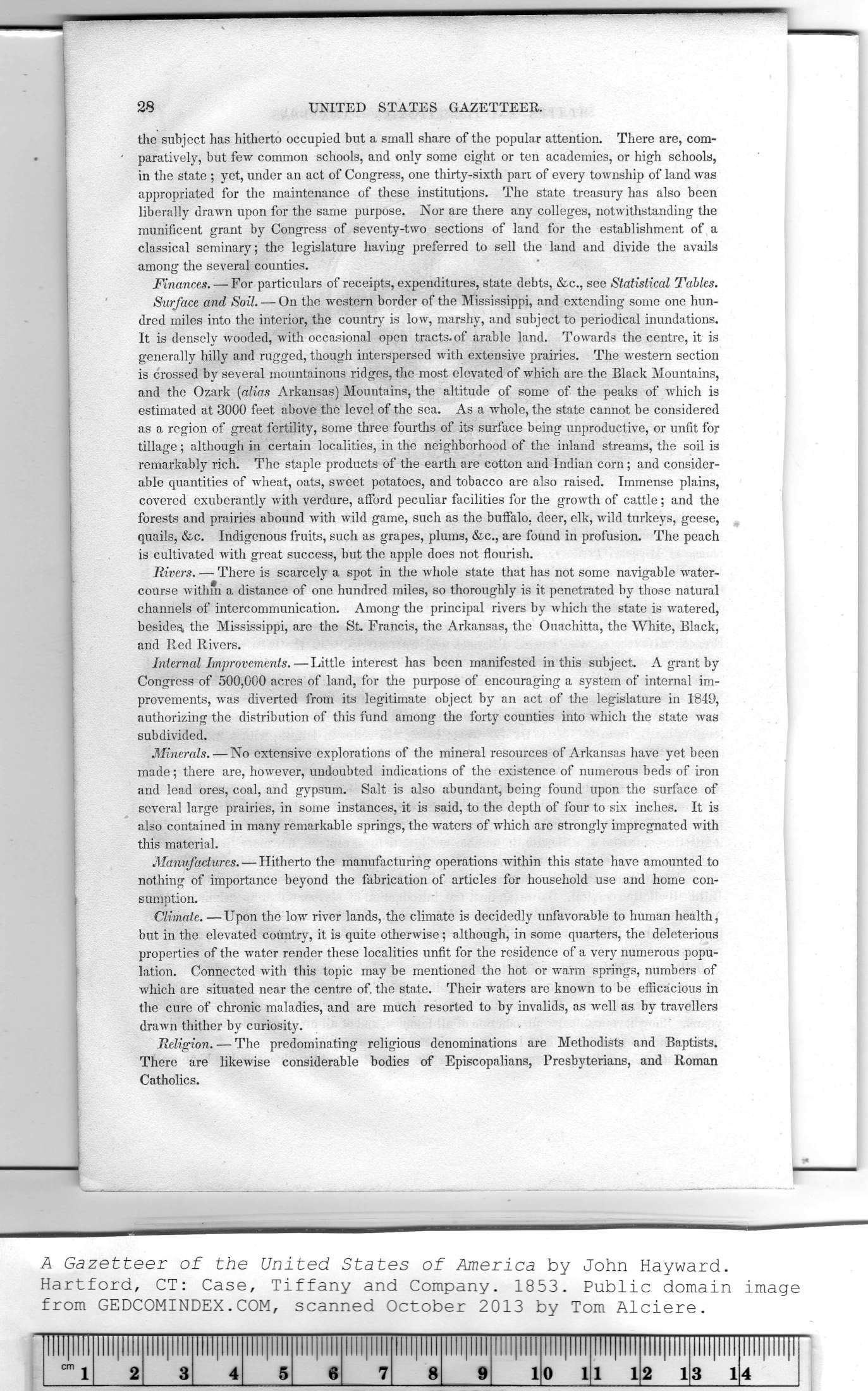|
|
Note: Ctrl and + increases the font size of the text below, Ctrl and - decreases it, and Ctrl and 0 resets it to default size.
28 UNITED STATES GAZETTEER.
the subject has hitherto occupied but a small share of the popular attention. There are, com-
paratively, but few common schools, and only some eight or ten academies, or high schools,
in the state ; yet, under an act of Congress, one thirty-sixth pan of every township of land was
appropriated for the maintenance of these institutions. The state treasury has also been
liberally drawn upon for the same purpose. Nor are there any colleges, notwithstanding the
munificent grant by Congress of seventy-two sections of land for the establishment of a
classical seminary; the legislature having preferred to sell the land and divide the avails
among the several counties.
Finances. — For particulars of receipts, expenditures, state debts, &c., see Statistical Tables.
Surface and, Soil. — On the western border of the Mississippi, and extending some one hun-
dred miles into the interior, the country is low, marshy, and subject to periodical inundations.
It is densely wooded, with occasional open tracts, of arable land. Towards the centre, it is
generally hilly and rugged, though interspersed with extensive prairies. The western section
is crossed by several mountainous ridges, the most elevated of which are the Black Mountains,
and the Ozark (alias Arkansas) Mountains, the altitude of some of the peaks of which is
estimated at 3000 feet above the level of the sea. As a whole, the state cannot be considered
as a region of great fertility, some three fourths of its surface being unproductive, or unfit for
tillage; although in certain localities, in the neighborhood of the inland streams, the soil is
remarkably rich. The staple products of the earth are cotton and Indian corn; and consider-
able quantities of wheat, oats, sweet potatoes, and tobacco are also raised. Immense plains,
covered exuberantly with verdure, afford peculiar facilities for the growth of cattle; and the
forests and prairies abound with wild game, such as the buffalo, deer, elk, wild turkeys, geese,
quails, &c. Indigenous fruits, such as grapes, plums, &c., are found in profusion. The peach
is cultivated with great success, but the apple does not flourish.
Rivers. — There is scarcely a spot in the whole state that has not some navigable water-
course withm a distance of one hundred miles, so thoroughly is it penetrated by those natural
channels of intercommunication. Among the principal rivers by which the state is watered,
beside^ the Mississippi, are the St. Francis, the Arkansas, the Ouachitta, the White, Black,
and Red Rivers.
Internal Improvements. — Little interest has been manifested in this subject. A grant by
Congress of 500,000 acres of land, for the purpose of encouraging a system of internal im-
provements, was diverted from its legitimate object by an act of the legislature in 1849,
authorizing the distribution of this fund among the forty counties into which the state was
subdivided.
Minerals. — No extensive explorations of the mineral resources of Arkansas have yet been
made; there are, however, undoubted indications of the existence of numerous beds of iron
and lead ores, coal, and gypsum. Salt is also abundant, being found upon the surface of
several large prairies, in some instances, it is said, to the depth of four to six inches. It is
also contained in many remarkable springs, the waters of which are strongly impregnated with
this material.
Manufactures. — Hitherto the manufacturing operations Avithin this state have amounted to
nothing of importance beyond the fabrication of articles for household use and home con-
sumption.
Climate. —Upon the Ioav river lands, the climate is decidedly unfavorable to human health,
but in the elevated country, it is quite otherwise; although, in some quarters, the deleterious
properties of the water render these localities unfit for the residence of a very numerous popu-
lation. Connected with this topic may be mentioned the hot or warm springs, numbers of
which are situated near the centre of. the state. Their waters are known to be efficacious in
the cure of chronic maladies, and are much resorted to by invalids, as well as by travellers
drawn thither by curiosity.
Religion. — The predominating religious denominations are Methodists and Baptists.
There are likewise considerable bodies of Episcopalians, Presbyterians, and Roman
Catholics.
|
|
|
lllllllll |
lllllllll |
llll|llll |
lllllllll |
llll|llll |
llll|llll |
lllllllll |
lllllllll |
lllllllll |
lllllllll |
lllllllll |
lllllllll |
lll!|ll!l|l |
|
on i ^ |
2 |
3 |
4 |
5 |
6 |
7 |
8 |
9 |
1 |
0 1 |
1 1 |
2 1 |
3 1 |
4 |
|
